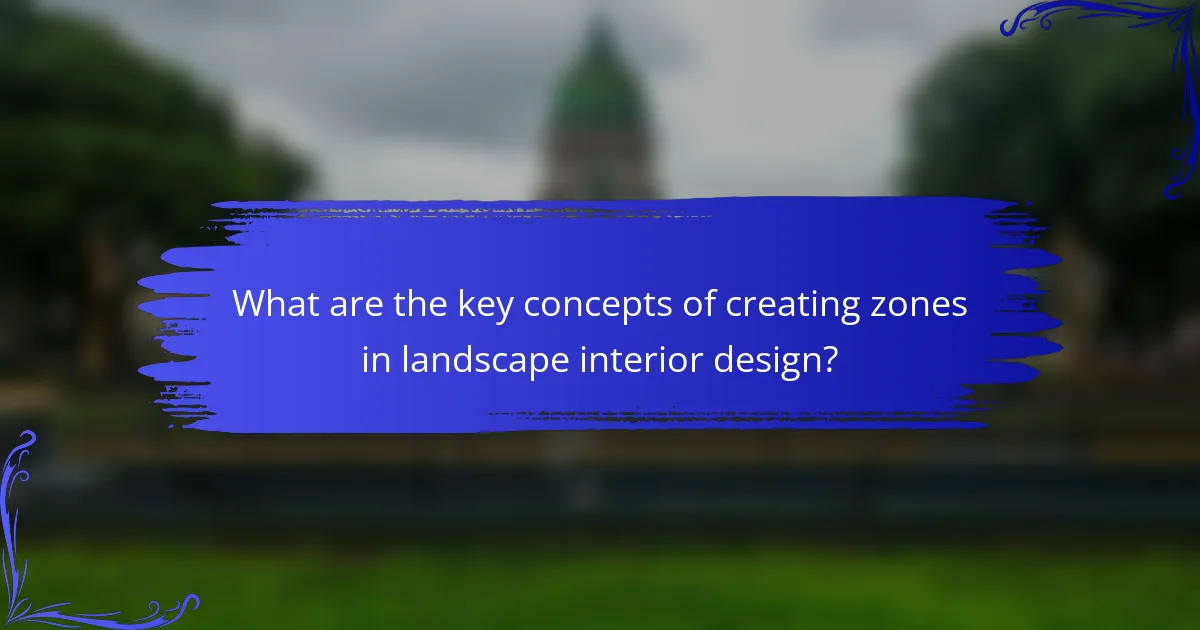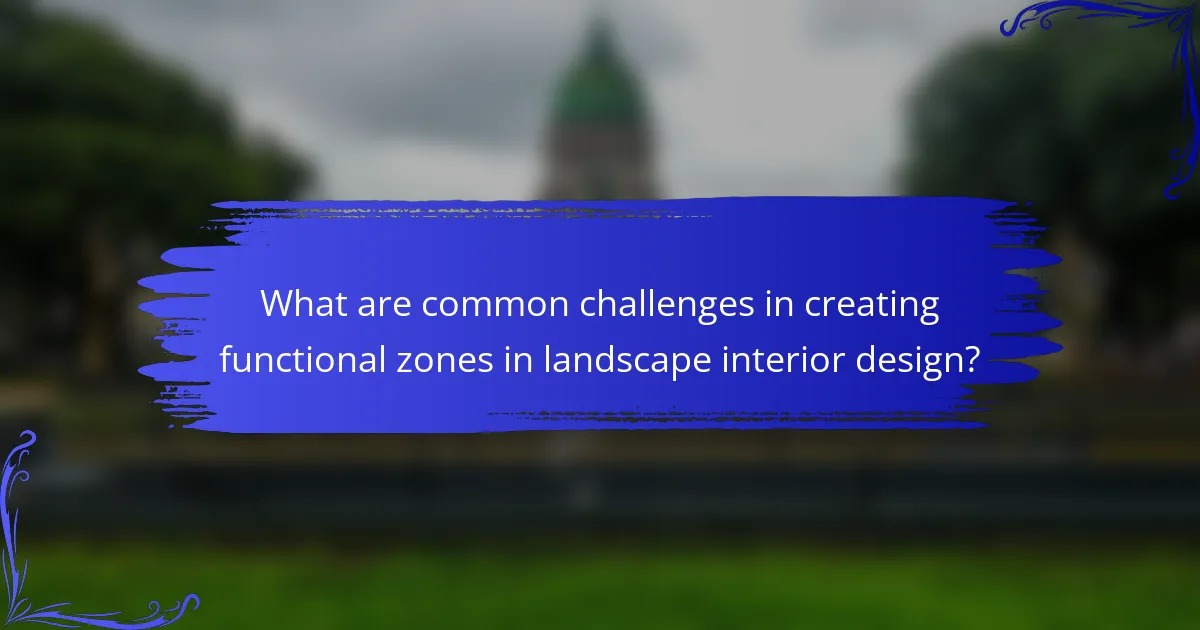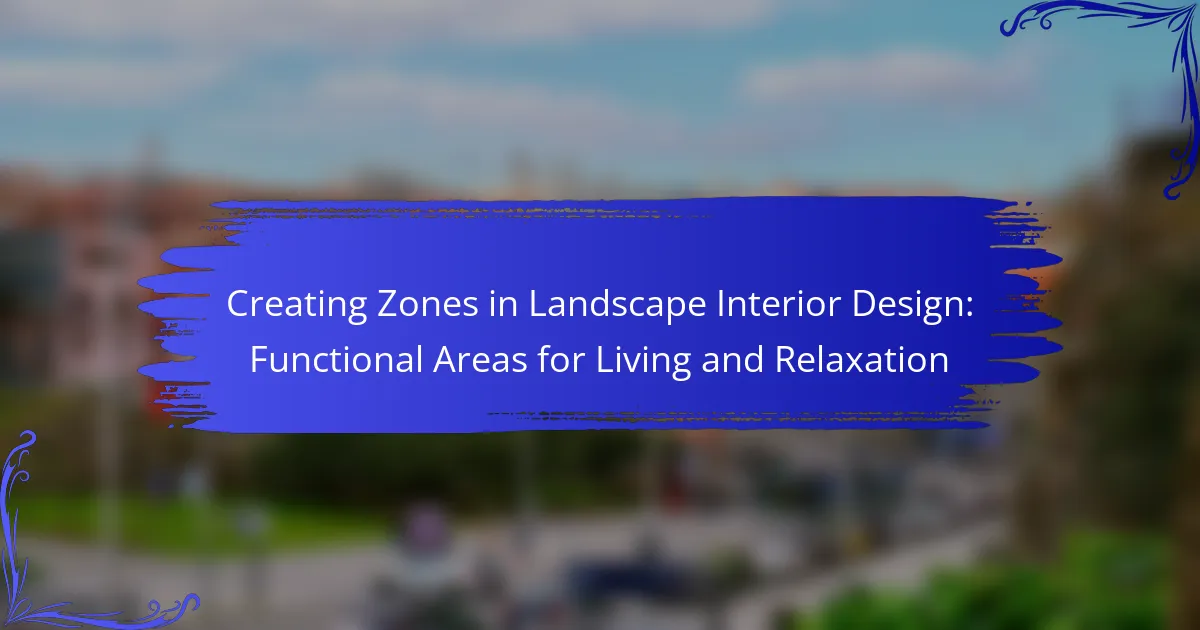Creating zones in landscape interior design focuses on defining functional areas for living and relaxation, enhancing user experience through thoughtful spatial organization. Key concepts include identifying specific purposes for each zone, such as relaxation or dining, and ensuring smooth transitions to promote accessibility. Incorporating natural elements like plants and water features, along with hardscape elements such as pathways and seating, further enhances the aesthetic and functional aspects of these spaces. Challenges in this design process can include space limitations, conflicting uses, and environmental factors, all of which must be addressed to achieve a harmonious outdoor environment.

What are the key concepts of creating zones in landscape interior design?
The key concepts of creating zones in landscape interior design include defining functional areas, establishing flow, and enhancing user experience. Defining functional areas involves identifying specific purposes for each zone, such as relaxation, dining, or play. Establishing flow ensures smooth transitions between zones, promoting accessibility and ease of movement. Enhancing user experience focuses on incorporating elements that cater to the needs and preferences of users, such as seating, lighting, and vegetation. Additionally, considering scale and proportion is essential to create harmonious spaces. These concepts are supported by design principles that prioritize functionality and aesthetic appeal in outdoor environments.
How do functional areas enhance living and relaxation spaces?
Functional areas enhance living and relaxation spaces by organizing them into distinct zones for specific activities. These zones improve flow and usability within a space. For example, a designated reading nook provides a quiet area for relaxation. Similarly, an outdoor dining space encourages social interaction and gatherings. Research shows that well-defined functional areas can reduce stress and increase comfort. A study from the Journal of Environmental Psychology highlights that spatial organization positively affects mood and well-being. By creating functional areas, designers can optimize both aesthetics and functionality in living spaces.
What types of functional areas can be created in landscape design?
Functional areas in landscape design include recreational spaces, gardens, pathways, and seating areas. Recreational spaces can be designed for activities like sports or play. Gardens can vary from flower gardens to vegetable patches. Pathways facilitate movement through the landscape. Seating areas provide spaces for relaxation and social interaction. Water features can enhance aesthetics and tranquility. Lighting can create ambiance and safety in functional areas. Each area serves specific purposes for living and relaxation.
How does zoning contribute to the overall aesthetic of a space?
Zoning enhances the overall aesthetic of a space by organizing areas for specific functions. This organization creates visual harmony and balance. Each zone can be designed with distinct characteristics, contributing to the overall design theme. For example, a relaxation zone may feature soft colors and natural materials, while a dining area might incorporate vibrant colors and structured layouts. Clear boundaries between zones help define their purpose and improve flow. Effective zoning can also highlight focal points, such as artwork or landscaping features. Studies show that well-defined spaces increase user satisfaction and engagement. Overall, zoning is essential for achieving a cohesive and visually appealing environment.
Why is it important to define zones in landscape interior design?
Defining zones in landscape interior design is important for optimizing space functionality. Zones help organize areas for specific activities, enhancing usability. They create a sense of order, making environments more inviting. Clearly defined zones improve flow and accessibility within the space. This organization can increase property value by appealing to potential buyers. Research shows that well-planned zones contribute to user satisfaction and comfort. Effective zoning can also facilitate better maintenance and upkeep of outdoor areas. Overall, defining zones leads to a more coherent and enjoyable landscape design.
What impact does zoning have on usability and flow within a space?
Zoning significantly enhances usability and flow within a space. It organizes areas for specific functions, such as living, dining, or relaxing. This organization helps users navigate the space more intuitively. For instance, clear delineation between zones reduces confusion about where to perform certain activities. Research indicates that well-defined zones can improve user satisfaction and comfort. A study by the American Society of Interior Designers found that effective zoning increases the perceived functionality of a space by up to 30%. Thus, zoning plays a crucial role in optimizing how individuals interact with their environment.
How can defined zones improve user experience in outdoor areas?
Defined zones enhance user experience in outdoor areas by providing clarity and organization. Clear boundaries help users understand the purpose of each space. For example, a designated play area encourages children to engage in activities safely. Meanwhile, a relaxation zone with seating invites users to unwind. Studies show that well-defined spaces can reduce confusion and increase user satisfaction. A survey by the American Society of Landscape Architects found that 75% of respondents prefer areas with distinct functions. This organization fosters social interaction by creating areas for gathering. Overall, defined zones improve accessibility and usability in outdoor environments.

What are the principles of effective zone creation in landscape design?
Effective zone creation in landscape design involves several key principles. First, it is essential to define the purpose of each zone. Each area should serve a specific function, such as relaxation, entertainment, or gardening. Next, consider the spatial organization. Zones should be arranged logically to ensure flow and accessibility.
Incorporating natural elements is also crucial. Plants, water features, and terrain variations enhance the aesthetic and functional aspects of each zone. Additionally, consider the scale of each area. Proportionality ensures that zones feel comfortable and inviting.
Finally, integrating hardscape elements like pathways and seating areas is important. These features help delineate zones and improve usability. Research indicates that well-defined zones can enhance user experience and satisfaction in outdoor spaces.
How does understanding space influence zone design?
Understanding space directly influences zone design by determining how areas are allocated and utilized. Space analysis helps identify functional needs and user behaviors. This leads to effective placement of elements such as seating, pathways, and vegetation. For instance, a well-understood space allows for the creation of distinct zones like dining, relaxation, and play areas. Research shows that thoughtful spatial planning enhances usability and aesthetic appeal. Studies indicate that spaces designed with user interaction in mind improve overall satisfaction and functionality. Therefore, understanding space is critical for creating harmonious and practical zones in landscape interior design.
What factors should be considered when determining zone size and shape?
Factors to consider when determining zone size and shape include the intended use of the space. Different activities require varying amounts of room. For example, a dining area needs more space than a lounging zone. The number of users also influences size; larger gatherings necessitate bigger zones. Accessibility is crucial; pathways must be clear and functional. Scale and proportion relative to surrounding elements affect visual harmony. Sunlight and shade patterns impact comfort and usability. Finally, existing landscape features, such as trees or slopes, can define or restrict zone shapes. These considerations ensure that zones are both functional and aesthetically pleasing.
How do environmental elements affect zone placement?
Environmental elements significantly influence zone placement in landscape interior design. Factors such as sunlight, wind patterns, and topography determine how spaces are utilized. For instance, areas with abundant sunlight are ideal for relaxation zones. Conversely, shaded spaces may be better suited for dining or activity zones. Wind exposure can affect the comfort of outdoor areas. Zones should be oriented to minimize wind impact while maximizing shelter. Topography also plays a role; sloped areas may require terracing for effective zone placement. Understanding these elements leads to functional and enjoyable outdoor spaces.
What role does functionality play in zone design?
Functionality is crucial in zone design as it dictates how spaces are utilized. Effective zone design enhances user experience by ensuring areas serve their intended purpose. For instance, a relaxation zone must provide comfort and tranquility. This can be achieved through appropriate seating, lighting, and landscape elements. Research indicates that well-designed functional zones improve user satisfaction and usability. A study by Kaplan and Kaplan (1989) highlights that functional design fosters positive interactions in space. Thus, functionality directly influences the effectiveness of landscape interior design.
How can different activities be accommodated within designated zones?
Different activities can be accommodated within designated zones by strategically planning the layout and functionality of each area. Each zone should serve a specific purpose, such as relaxation, recreation, or social interaction. For example, seating areas can be designed for gatherings, while quiet corners can encourage solitude. Clear pathways should connect these zones, promoting easy navigation between activities. Additionally, incorporating diverse elements like plants, furniture, and lighting can define each zone’s atmosphere. Research shows that well-defined spaces enhance user experience and satisfaction. A study by Kaplan and Kaplan highlights that distinct areas can improve user engagement and comfort in landscape design.
What strategies can be used to enhance the functionality of each zone?
To enhance the functionality of each zone in landscape interior design, implement clear spatial organization. Define each zone with distinct boundaries, such as plants or furniture. This promotes specific uses for living and relaxation areas. Incorporate flexible furniture to adapt to various activities. For example, movable seating can accommodate gatherings or quiet time. Use appropriate lighting to create ambiance and improve usability during different times of the day. Natural light should be maximized in relaxation zones for comfort. Integrate pathways to facilitate movement and access between zones. This ensures a seamless flow throughout the landscape. Utilize sensory elements like water features or aromatic plants to engage users. These strategies collectively enhance the overall experience of each functional area.

What are common challenges in creating functional zones in landscape interior design?
Common challenges in creating functional zones in landscape interior design include space limitations, conflicting uses, and environmental factors. Space limitations can restrict the size and layout of zones. Conflicting uses arise when different activities compete for the same area. Environmental factors, such as sunlight and wind, can affect the usability of outdoor spaces. Additionally, maintaining privacy while ensuring accessibility presents another challenge. Integrating aesthetics with functionality can complicate design decisions. Lastly, budget constraints may limit the materials and features that can be included in the design.
How can designers overcome limitations in space?
Designers can overcome limitations in space by utilizing multifunctional furniture and optimizing layout. Multifunctional furniture allows for efficient use of limited areas. For example, a sofa bed serves as both seating and sleeping space. Optimizing layout involves strategic arrangement of elements to maximize flow and usability. Designers can create open pathways and define zones with rugs or furniture placement. Vertical space can also be used effectively with shelving or wall-mounted storage. Incorporating mirrors can enhance the perception of space by reflecting light. These strategies have been proven to enhance functionality in small areas, as seen in various interior design studies.
What solutions exist for integrating multiple zones in small areas?
Solutions for integrating multiple zones in small areas include using multifunctional furniture, vertical gardening, and strategic layout design. Multifunctional furniture can serve multiple purposes, maximizing space efficiency. For example, a sofa bed provides seating and sleeping areas in one unit. Vertical gardening utilizes wall space for plants, enhancing aesthetics without consuming ground area. Strategic layout design involves arranging furniture and zones to promote flow and accessibility. This can include open pathways and defined areas for different activities. Research shows that these methods effectively create distinct yet cohesive spaces in limited areas, improving both functionality and visual appeal.
How can one address environmental constraints when designing zones?
One can address environmental constraints when designing zones by conducting thorough site assessments. These assessments identify factors such as soil quality, drainage patterns, and native vegetation. Understanding these elements allows for appropriate plant selection and placement. Incorporating sustainable practices like rainwater harvesting can mitigate water scarcity. Utilizing native plants reduces maintenance and supports local ecosystems. Implementing erosion control measures protects the landscape from degradation. Additionally, considering sunlight exposure helps in selecting suitable areas for specific functions. By integrating these strategies, designers can create functional and sustainable zones.
What are best practices for ensuring successful zone implementation?
Successful zone implementation requires clear planning and defined objectives. Begin by assessing the space and identifying functional needs. Create a detailed design that outlines each zone’s purpose. Utilize appropriate materials and plants that align with the intended use. Ensure proper flow and accessibility between zones. Regularly evaluate the zones for effectiveness and make adjustments as necessary. Engaging professionals can enhance design quality and implementation. Research indicates that well-defined zones improve user satisfaction and functionality in landscape design.
How can one effectively use materials to define and enhance zones?
One can effectively use materials to define and enhance zones by selecting appropriate textures and colors. Different materials can create visual boundaries between areas. For example, using stone for pathways can delineate walking zones. Wood can provide warmth in relaxation areas. Textiles can soften spaces and add comfort. The contrast between hard and soft materials can enhance the distinction of zones. Research shows that varied materials influence spatial perception and user experience. For instance, a study by the University of Cambridge highlights how material choice affects emotional responses in environments. Thus, strategic material selection plays a crucial role in zone definition and enhancement.
What maintenance considerations should be taken into account for different zones?
Maintenance considerations for different zones include assessing plant health, soil condition, and irrigation needs. Each zone may have unique environmental factors. For example, shaded areas require less water than sunny zones. Regular pruning is essential in high-traffic zones to maintain aesthetics and safety. Fertilization schedules should align with the growth cycles of plants in each zone. Pest control strategies may vary based on the specific plant species present. Additionally, hardscape elements like pathways and patios need periodic cleaning and repairs. These considerations help ensure the longevity and functionality of each zone in landscape design.
What practical tips can be applied when creating zones in landscape interior design?
To create zones in landscape interior design, start by defining the purpose of each area. Identify functional needs such as relaxation, dining, or play. Use physical barriers like hedges, walls, or furniture to delineate spaces. Incorporate varied textures and colors to visually separate zones. Consider pathways for flow between areas, enhancing accessibility. Integrate lighting to highlight specific zones, creating ambiance. Use plants to soften boundaries and add natural elements. Regularly assess the layout for usability and comfort based on user feedback. These strategies enhance both functionality and aesthetic appeal in landscape design.
Creating Zones in Landscape Interior Design focuses on the establishment of functional areas that enhance living and relaxation spaces. Key concepts include defining specific purposes for each zone, ensuring smooth flow and accessibility, and improving user experience through thoughtful design elements. The article outlines various types of functional areas, discusses the importance of zoning for aesthetics and usability, and highlights effective strategies for overcoming common design challenges. Additionally, it emphasizes the role of environmental factors, material selection, and maintenance considerations in successful zone implementation.
